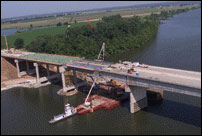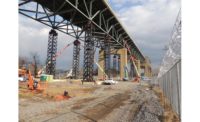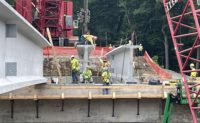The Interstate-40 bridge in Webbers Falls, Okla., which collapsed May 26 when it was hit by a barge, reopened on July 29, just 65 days after the accident. That's less than half of the six months that the Federal Highway Administration says it normally would take for such a project. Fourteen motorists died when four of the bridge's spans fell.
 |
| July 1 phot of I-40 bridge, from downstream. (Photo courtesy of Oklahoma DOT) |
Contractor Gilbert Central Corp., a Fort Worth-based unit of Peter Kiewit Sons' Inc., beat its proposed 57-day schedule by better than 10 days. Oklahoma Dept. of Transportation let bidders propose schedules of up to 72 days. It reconstructed a 600-ft-long portion of the bridge across the Arkansas River in eastern Oklahoma.
Gilbert Central received $10.9 million for the base contract, plus incentive payments totaling slighly more than $1.5 million$6,000 for each hour by which it beat its proposed schedule. If the firm missed its proposed schedule, it would have lost $6,000 per hour.
FHWA says the total estimated project cost is $24 million, including detours around the damaged bridge. The project used what FHWA terms "a modified design-build approach" that permitted design to be done in only 16 days.
Oklahoma DOT Director Gary Ridley says, "With a major coast-to-coast traffic artery interrupted by the bridge disaster, rapid reconstruction was imperative, and all parties came through brilliantly."
The agency set up a special "Webbers Falls Residency," led by a team of three of its former engineers, called out of retirement to oversee the job. ODOT residencies typically look after multiple projects in several counties but this one focused just on the I-40 bridge.
Kiewit Division Manager Scott Cassells said, "We empowered the team in the field, and they met two or three times each day tomonitor progress and keep the communication lines open." The company called on more than 100 people from three Kiewit districts. Its equipment contingent included seven cranes.
FHWA's Oklahoma Division helped with technical assistance and aided ODOT in evaluating and carrying out the incentive contract. FHWA Administrator Mary E. Peters praised all hands involved in the job--federal, state and private-sector. She said, "The success of these innovative approaches sends an important signal to all Americans that our nation has the ability to make immediate repairs to our road and bridge system that minimizes economic impact and provides needed mobility and safety to motorists."
Oklahoma DOT says some lane striping and other minor work remains to be done at the site, requiring periodic lane closings.



Post a comment to this article
Report Abusive Comment